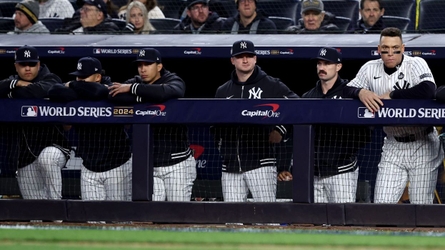PORT ST. LUCIE — Glenn Sherlock was not sure he’d ever see this day.
As a young coach in the Yankees’ minor league system in the late 1980s, Sherlock had participated in the lengthy meetings that codified the Yankees’ facial hair policy, among many other ideas and rules that have defined the organization for generations. Then he was one of the many people tasked with enforcing it.
“I’m extremely surprised,” Sherlock, now the Mets’ catching instructor, said at Mets camp on Friday morning as news spread of the Yankees’ decision to finally allow players to wear beards. “During [pregame] stretch, if anyone came out unshaven, we would have to send them back in to shave.”
As Sherlock knows firsthand, the story of the rule’s genesis and history is richer than most fans realize. And in fact, the Yankees have updated several of the rules about personal appearance over the past decade or so. Facial hair was merely the highest-profile bullet point.
The origin (which I learned while reporting my book, The Yankee Way, on which much of this article is based) of the policy stretches back to the mid-1970s, when new owner George Steinbrenner wanted players to mirror the look that he experienced while attending military school and serving in the U.S. Air Force. Steinbrenner ordered players to trim their hair and facial hair, but the policy was not yet codified in writing.
The long process began with a chance encounter in 1976 between Steinbrenner and a college coach named Jack Butterfield. The two met at an event at the University of South Florida, where Butterfield was then working.
Butterfield impressed Steinbrenner with his depth of knowledge and all-business personality. Soon after, Steinbrenner hired him to run scouting and player development.
“Dad was organized and detailed,” Brian Butterfield, Jack’s son and a decorated coach himself, told me in a 2022 interview. “He was in perfect line with what Mr. Steinbrenner represented. Mr. Steinbrenner was extremely disciplined — the short hair and playing the game the right way. He had a football background, and dad had also been the football coach at [the University of] Maine. Mr. Steinbrenner valued toughness, and dad believed in all the same things. He was fearless.”
Jack Butterfield died in a car accident in 1979. Steinbrenner promoted one of his proteges, Bill Livesey, to replace him.
One spring training in the early ‘80s, Livesey learned firsthand the importance that Steinbrenner placed on players’ personal appearance.
On a particular morning, several squads of Yankee minor leaguers were playing Baltimore on a backfield. Steinbrenner sat between the fields, glowering.
“Livesey, come here!” he barked. “You see those uniforms?”
“Our uniforms?” Livesey said.
“No!” Steinbrenner answered. “The Baltimore uniforms!”
Sure enough, the name patches on the back of the Orioles’ jerseys were sloppily applied and peeling off.
“If I ever see a Yankee uniform like that, you’re gone!” Steinbrenner said.
Recalling that in 2022, Livesey laughed and said, “He can’t find anything we’re doing wrong, so he warns me about the other team’s uniforms!”
In the late ‘80s, Livesey and Mark Newman, another longtime Yankees player development official, convened a study group of sorts to work on a manual that defined a Yankee way. Among those who gathered were Sherlock, Buck Showalter, Brian Butterfield; and future Philadelphia Phillies manager Rob Thomson.
“I remember sitting in a room with all the coaches, along with Mark Newman and Bill Livesey, when Bill and Mark were putting this together,” Sherlock said in 2022. “They would ask questions that drew from everybody’s expertise in that room. We had a lot of young coaches, but we had a lot of experienced coaches in there, too.
“It was interesting, the attention to detail. When Mark Newman was asking about outfield play, I can remember sitting in that room and listening to [former major leaguers] Ted Uhlaender and Clete Boyer getting into this discussion: whether you should catch the ball on your left side of your body or the right side of your body or over your head. This was going on for hours. At some point it was like, man — it was and on and on and it was just a small thing. But I’ll just never forget how much time we spent talking about it. People gave their opinions, explained them, and Mark and Bill put it all together.”
The book that emerged, The Yankee Systems Development Manual, came in at approximately 500 pages. The vast majority covered baseball technique, but the first chapter set in writing the rules for how a Yankee should look.
They were:
— No jewelry with the Yankee uniform.
— Hair no longer than the collar.
— Uniform pants must be bloused.
— Four inches of blue must show on stirrups.
— No beards.
As decades passed, the three-ring binder evolved to become a CD-ROM, then a flash drive, then an element of the Yankees’ iPad app (it was the job of current Yankees assistant hitting coach Pat Roessler to oversee each update, which he once told me was “a lot of f–king work!”). But as the technology progressed, the Steinbrenner/Butterfield rules on personal appearance remained until about a decade ago.
This week’s news about the facial hair policy was not in fact the first amendment to those regulations. Yankees general manager Brian Cashman told me on Friday that he ended the requirements regarding the blousing of pants and showing four inches of stirrups after Newman retired in 2014.
Cashman felt — and Mets manager Carlos Mendoza, a Newman protégé and longtime Yankees staffer, agreed — that the high socks and bloused pants actually impacted evaluations because they made players look larger and less athletic than they were.
Cashman also said on Friday that, despite the change in beard policy, the Yankees’ rules on hair length and jewelry remained in place.
Read the full article here


